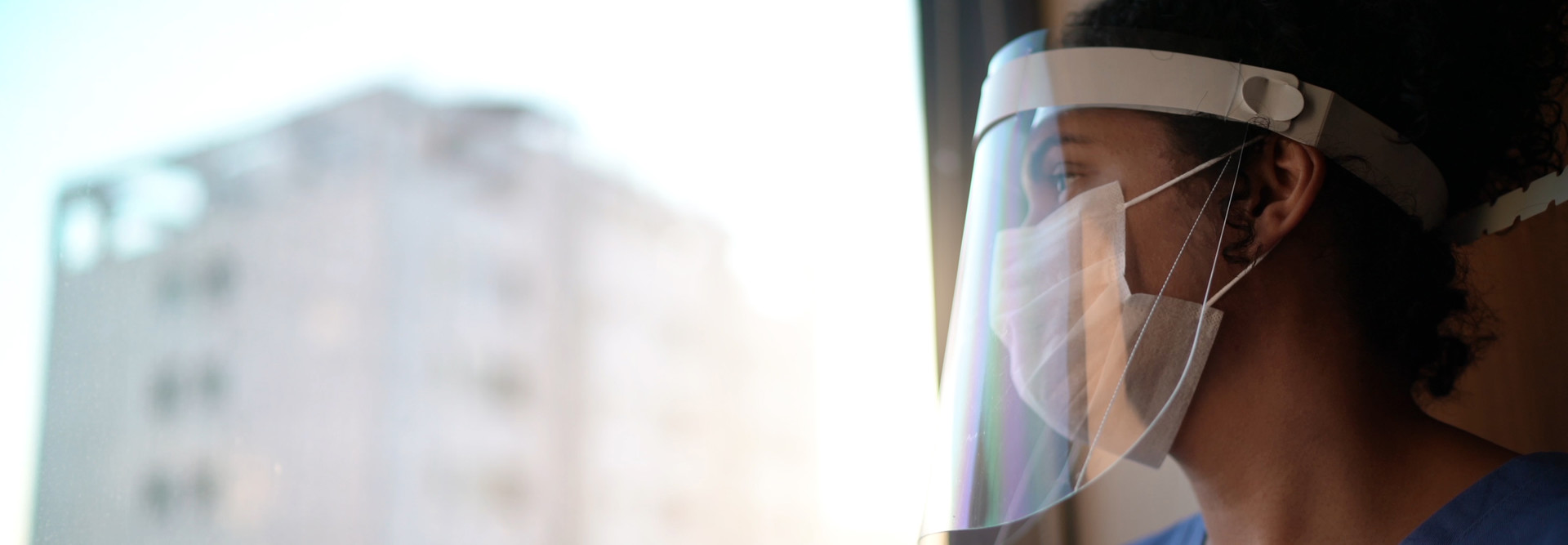Once inside, patients may expect touch-screen kiosks and fewer areas to congregate.
St. Joseph Health’s Queen of the Valley Medical Center in California is creating an emergency department with lounge space immediately outside exam rooms for up to four guests, according to CannonDesign, a global design firm. The company also cites University of Minnesota Health, which significantly reduced the number of waiting areas in response to COVID-19; visitors are given radio-frequency identification badges so they can move throughout the building until called.
Robots, Bedside Collaboration Tools Minimize In-Person Contact
Admitted patients aren’t excluded from social distancing. Those recovering in a hospital bed — regardless of exposure to or risk of contracting COVID-19 — may be asked to visit with a clinician virtually to conserve protective equipment and shield clinicians.
Robust Wi-Fi connectivity paired with collaboration software and mobile devices allows groups of caregivers to consult from anywhere.
The practice of “virtual rounding” boosts safety and efficiency among teams, notes Dr. Brett Meyer, medical director of enterprise telemedicine at UC San Diego Health, which deployed a remote rounding tool using iPad devices, Zoom and the Apple management solution Jamf to easily connect to any room with a click.
“Not only are you able to provide the same level of care but you’re able to do a better job of making sure your team is informed,” Meyer tells HealthTech.
In other cases, nonsurgical robots fitted with tablets or videoconferencing tools can enter patient rooms to facilitate a conversation. Inside its intensive care unit, Orlando Health teams sent robots equipped with a telehealth platform to check vital signs from monitors.
READ MORE: Discover three trends set to influence healthcare as staff return to work.
Some machines can aid other parts of care delivery: At Adventist Health White Memorial in Los Angeles, robots that emit germ-killing ultraviolet light are used to decontaminate rooms in as few as 10 to 15 minutes without human contact, wirelessly sending confirmation to a secure, cloud-based portal.
Robots also can be team players in delivering linens, medications and other items. A fleet of six Aethon TUG robots at MedStar Washington Hospital Center in Washington, D.C., executes hundreds of tasks daily (collectively, the robots traveled 2,974 miles and completed 26,574 stops last year, according to the hospital).
Remote Patient Monitoring for COVID-19 Patients Keeps Care Going
With hospital beds and in-house resources stretched more than ever, healthcare organizations are helping patients better manage their care at home when it’s deemed safe to discharge them.
Not only does this free up space for newly admitted individuals but it can prevent costly and life-threatening readmissions by catching problems before they arise.
Remote patient monitoring (RPM) programs that use data-collection tools to gather and transmit vital signs to a clinician can play a key role during recovery, regardless of the health issue. The technology, depending on its intended application, can track heart rate, oxygen saturation and even medication adherence.
Often, the devices — such as scales and blood pressure gauges — connect to patients’ tablets or smartphones via Bluetooth; those consumer devices use Wi-Fi to transmit readings back to the hospital.
RPM is also aiding with the unique challenges of COVID-19 aftercare. Recent studies connecting the disease to long-term heart and lung damage, among other detrimental side effects, underscore the value of high vigilance during this period.
Among the efforts:
- At Cleveland Clinic, a partnership with Epic allows recovering COVID-19 patients to enroll in a 14-day interactive care plan using Epic’s MyChart patient portal at home. They can enter symptoms, temperature and oxygen saturation once daily. Care providers will be automatically notified if symptoms worsen.
- Providence St. Joseph Health patients who exhibit virus symptoms but are well enough to stay home are given a thermometer and pulse oximeter that connect with solutions from Twistle, Xealth and digital platforms monitored by Providence clinicians. It’s just one part of Providence’s digital COVID-19 strategy.
- OSF HealthCare launched an outreach program for those who are at high risk of contracting the virus or who are showing early symptoms. Participants receive a telehealth kit that includes a laptop with preloaded RPM apps. Patients monitor their signs and communicate twice daily with a nurse by phone or virtual visit.
Interest in RPM was high before the pandemic. A 2019 survey conducted by a wearable solutions provider found that two-thirds of patients 40 and older would use a health monitoring device if it meant they could reduce the number of times they had to physically visit a doctor or hospital.
As the COVID-19 pandemic continues and organizations work to expedite and evolve their onsite care, a strong home-based component using RPM is poised to grow with it.











